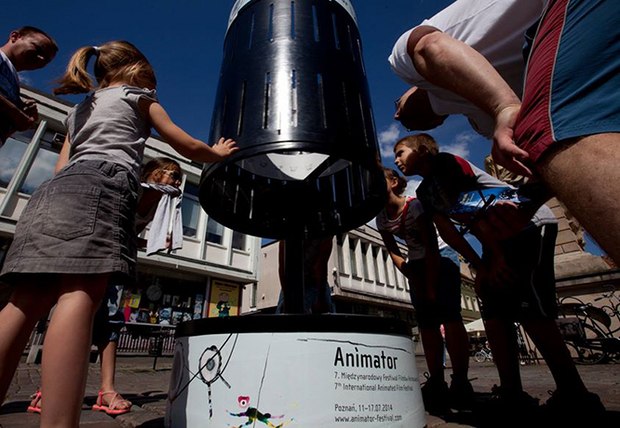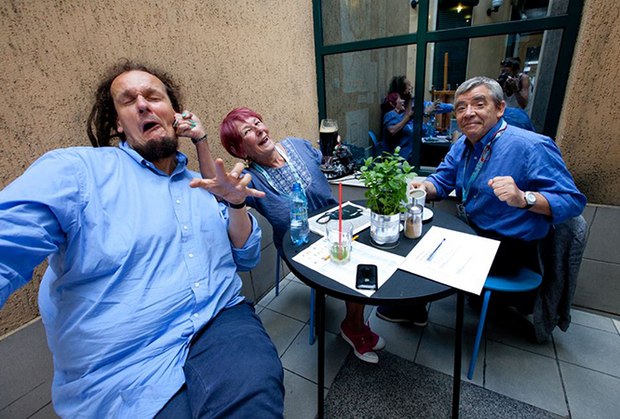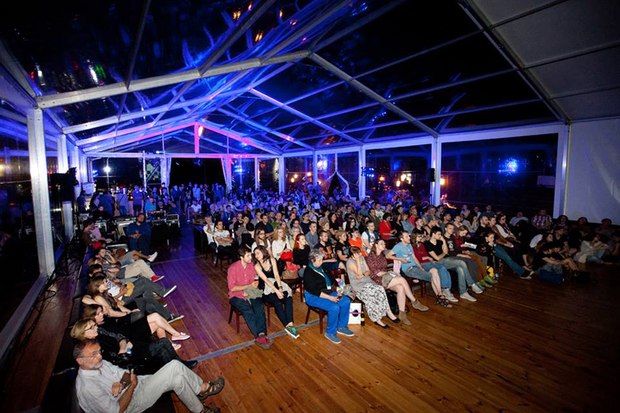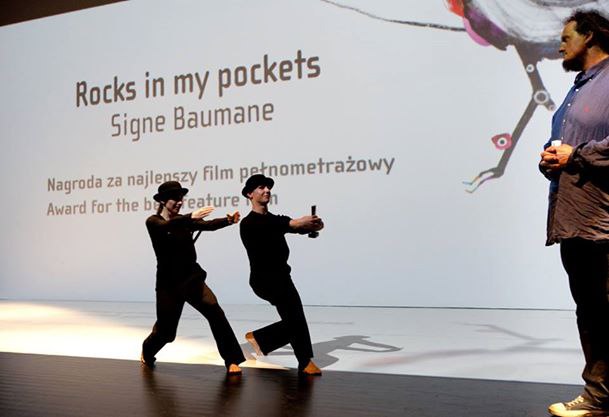ANIMATOR International Animated Film Festival in Poznan, Poland is a festival with a strong focus on live performance as well as the normal fare of short and feature length animation as well as workshops and panel discussions.
ANIMATOR International Animated Film Festival in Poznan, Poland is a festival with a strong focus on live performance as well as the normal fare of short and feature length animation as well as workshops and panel discussions. This year’s Animator Festival offered several really challenging works in their six shirt film competition programs.
I was completely repulsed after I saw Polish animator Piotr Dumala’s film Hipopotamy but I couldn’t stop thinking about it. The film starts off calmly with a group of faceless naked women and children bathing in a river. They are being secretly observed by a group of men. A naked man approaches a woman with a child in her arms who rejects his advances. So begins a brutal and at the same time beautifully graceful “dance” of naked bodies reflected in the water. The title of the film was inspired by the behaviour of hippopotami, which are very aggressive animals.
The next morning I still couldn’t get Hipopotamy out of my head and I finally concluded that it is a very important work, especially in this day and age when so much cruelty and violence is happening all over the world. The film asks questions about “Who are we?” “What separates us from animals that kill each other for food and survival?” and “How can human beings do this to each other?” Although Hipopotamy has no answers, only questions, and it is repulsive and shocking, the images challenge the audience to think. Piotr received the Wojciech Juszczak Special Award for Artistic Merit at the festival.
A new film by the incredibly talented identical twin brothers Stephen and Timothy Quay is always an event. Their latest film Unmistaken Hands: Ex Voto P.H. is a 26 minute stop motion puppet animation exploring the inner worlds created by Uruguayan writer Felisberto Hernandez. The film serves as an “ex-voto portrait of the writer that Gabriel Garcia Marquez claimed taught that “the most haunting mysteries are those of everyday life”. Every film made by the Quay Brothers is a visual feast for the eyes and full of “magic realism”. Unmistaken Hands: Ex Voto P.H. was awarded the Grand Prix/Golden Pegasus Award.
I was on the feature film jury and I had only seen one of the films, Bill Plympton’s Cheatin’ before. I have been looking forward to seeing Signe Bauman’s Rocks In My Pocket and the wait was well worth it. Signe’s film is a very personal story about the women in her family including herself and their battles with depression. It raises questions about how much genetics determines who we are and if it is possible to outsmart one’s DNA. Packed with visual metaphors, surreal images and Signe’s twisted sense of humor the film is full of art, women, and strange daring stories.
Signe was born in Latvia and now lives in New York City. Signe narrates the film and her Latvian accent adds to the personal feeling of her story. She did tell me that she worked a great deal with a voice coach before beginning the recording because she wanted to make sure that her voice added not detracted from the film. The title of the film refers to her grandmother Anne who tried to drown herself (and of course to Virginia Woolf who loaded her pockets full of rocks and drowned herself on the River Ouse in Sussex, England).
Rocks In My Pocket is definitely not your typical animated feature and the subject matter may be very unpleasant for some viewers. Signe uses animation to tell a very personal story that could not have been done in live action. I highly recommend that every adult see the film, but leave the children at home.
The other feature that really impressed me was the French film Jasmine also based on a true story. Animator Alain Ughetto relates his romantic meeting with a young Iranian student, Jasmine, in France that changed the course of his life. Set primarily in 1978 Teheran against the back drop of the revolution, Alain joins Jasmine in Iran where their love grows clandestinely. They hope for a new life together in Iran, but the rise of the Islamic Republic destroys their illusions and seperates the two lovers. Thirty years later Alain goes searching for Jasmine.
The story is very sensitive; however, the animation technique that Ughetto employs is somewhat crude. The sets made out of layers of cardboard are very clever, but the plasticine figures are very plain with simple finger indentations for the facial features. Also several times we see the animator’s hands as he changes the shape of the two main characters. A note at the end of the film says that the Iranians who worked on the film did not want to risk having their names in the credits which made me think about the situation for artists in Iran today. The faded photos of Alain and Jasmine which concluded the film made the story very real but somehow I just couldn’t get past the technique.
When it came down to making our final decision our jury had a difficult time because there were strong points in favour of several of the films. After an intense discussion of all of the pros and cons we selected Rocks In My Pocket as the best feature film. A few days before the film had also won the Fipresci prize awarded by the International Federation of Film Critics at the International Film Festival Karlovy Vary.
My fellow members of the feature jury were Polish animator and illustrator Mariusz Wilczynski and Italian animation educator Alfio Bastoancich, producer and founder of the noted Cartoon by the Bay International Television Festival. He also has a long list of other credits in the animation world. I had never met Alfio before and it was a pleasure getting to know him. He is a lovely intelligent gentleman.
Along with the competition programs there was a wide variety of screenings presented by festival guests and numerous workshops. Experimental animator David Erlich teaches in China and presented programs of recent Chinese Independent Animation, Chinese Graduation Animation, and Classical Chinese Animation for children. People in the West have such limited opportunities to see Chinese animation that is creative and beautifully done, so David’s programs were a special treat.
The Independent Chinese animation was very impressive especially since it is still not easy for young animators in China to create original personal films. Entry level jobs for animation graduates average 3,000 rmb ($500.00 US dollars) per month. Rent for a small, one bedroom apartment plus utilities and internet also averages about another 3,000 rmb. Entry level jobs also require an animator to continue his commercial work in the studio well into the evening hours.
If a young animator does succeed in making a film it costs money to send it to festivals and a trip to a Western festival is totally prohibitive. Of course there are exceptions. Zhiyoug Lo became well-known when Kung Fu Bunny # 3 won a prize at Annecy and Lei Lei has been making films and traveling to festivals for several years. He has become well known, not only winning awards for his films but also being asked to design festival posters and create festival trailers.
I especially enjoyed the children’s program which contained such gems as Clever Ducklings made by Yu Zhenguang in 1960. It was made using a paper folding technique during the Golden Age of Shanghi animation. The remaining films were from the 1980’s, the second Golden Age of Chinese animation, which gained momentum right after the great proletarian revolution.
Pat O’Neill, a founding father of the Los Angeles avant-garde film scene, was another guest of the festival. He is a pioneer of optical effects and is known for his short films from the 1960’s onward. Pat’s films reflect a complex and mysterious interest in the connections and clashes between the natural world and human civilization. One of O’Neill’s best known films is Water and Power which was shot primarily in California’s Owens Valley. The title comes from the historical agency responsible for supplying water to Los Angeles at the beginning of the 20th Century. The film is not about history though, but rather the flow of political power as represented by water, and with water itself in all of its states, as well as with light, as it reveals planetary rotation and seasonal changes. His films are housed in The Academy of Motion Picture Arts and Sciences Film Archives.
Pat taught at Cal Arts where he influenced a generation of students several of whom went on to work on special effects for the original Star Wars. In the two programs he presented he combined found footage with experimental montage and compositing techniques.
Canadian animator Steven Woloshen is a master of the cameraless abstract film. Using every technique imaginable from burying film in the ground to scratching on it, Steven creates his films anywhere from airports, in airplanes, and even in his car using a small wooden box containing raw film footage with ink, assorted marking tools, and a flashlight. He works directly on previously exposed film and has made numerous short abstract works in which the images are created in synchronization with the sound track.
Steve presented two programs at the festival. The first screening showcased 18 of his own films. The second program featured films made by animators from around the world who made experimental cameraless films (works by Len Lye, Caroline Leaf, Norman McLaren and other artists.)
My fellow juror Alfio Bastiancich brought two programs of works by the brilliant Italian animator Bruno Bozzetto. Bruno is a master at clever storytelling and comic timing. In 1999 he made one of my favorite films, Europe vs Italy which compares the differences between typical behaviour of Italians and Europeans in such every day activities as parking a car or ordering an espresso. It is an extremely funny film. I always think of Bruno as an animated anthropologist.
Bozzetto’s masterpiece is his 80 minute Allegro non Troppo. The film uses well-known classical music pieces that inspired Bruno to create the separate stories that make up the film which is a mixture of live action and animated characters. Allegro non Troppo has been compared to Disney’s Fantasia, which Bruno says he used as his inspiration.
My other fellow juror Polish animator Mariusz Wilczynski and I became friends when we were on the short film jury together at a previous ANIMATOR festival. He had told me about the feature film that he had been working on since 2005 and this year Mariusz presented excerpts from it as a work in progress. Kill It And Leave Town is an “autobiographical impression, reminiscence of his childhood memories and images, which brings back his deceased parents and family landscape of Lodz”. The film has voiceovers by famous Polish actors and will have its world premiere in February 2017. Judging from the clips that I saw I am really looking forward to seeing the completed film.
Throughout the seven days of the festival there were numerous workshops for all ages, but there was so much to do I wasn’t able to see them all. When I visited Polish animator Izabela Pluci?ska’s Cut Out Animation workshop everyone was busy with scissors and paper. When all of the workshops presented their finished short films at the festival club I was very impressed with the lovely work Izabela’s group had completed in just a few days. Another workshop for 7 to 12 year olds taught the young animators the basics of working in stop motion with clay.
Steven Woloshen conducted Scratchatopia to instruct people in the unique techniques he uses to create cameraless animation, and Patryk Lichota led a workshop in creating sound sculptures, where the participants created a roomful of interesting objects which made sound in one way or another.
I was asked to participate in the two day Women in Animation academic conference which turned the spotlight on prominent female animators and their role in animation today. Topics ranged from Pushed into the Background, Female Animators in the Shadow of the Masters to a presentation on the Polish painter, illustrator and film maker Franciszka Themerson by Agnieszka Taborska. Agnieszka, wife of festival artistic director Marcin Gizycki, is a noted author and art historian in her own right.
My presentation was titled Joy Batchelor – Britain’s Unsung Heroine of Animation. We are all aware that 2014 is the centenary of Norman McLaren’s birth but most people don’t realize that it is also the 100th anniversary of the birth of British animator Joy Batchelor. My program included a short film about Joy titled Ode To Joy made by her daughter Vivien Halas and animator Martin Pickles to celebrate Joy’s immense contribution to animation as half of the renowned British animation studio Halas and Batchelor, which she co-founded with her husband John Halas.
Joy was responsible for much of the writing, direction and design for most of the films the studio made over its 40 year history. While her husband John managed the studio, Joy remains uncredited on many of the films. She did all of this while raising a family and running the house. After the great success of Halas and Batchelor’ Animal Farm, Britain’s first feature length animated film, for which Joy did receive directorial, production, script and design credits, Life Magazine did a feature article about Joy but rather than wanting pictures of her at the studio they asked her to pose working at home with her children playing under her desk while she drew. To conclude my program I showed some of her uncredited films created by the studio as WW II propaganda and an excerpt from Animal Farm.
Each year the festival invites someone to write an in-depth essay for the catalog. This year I was very honoured to join the ranks of such noted animation historians as Giannalberto Bendazzi as the 2014 essayist. My paper was The Rise and Fall of the Fleischer Studio – An Innovator in Early Animation. The studio’s numerous contributions to the early development of animation has always fascinated me.
As well as screening programs of animation, Animator puts a strong emphasis on the relationship between music and image. Each evening the action moved to the festival club for a concert. The programs ranged from jazz to pop music provided by different Polish musicians. The concerts were followed by a screening.
The festival has made some very positive changes since we were last there. The first improvement was apparent when we gathered in the large Festival Club for the opening night ceremony. The Club, which was the venue for all evening screenings and the live music, was a huge white industrial sized tent with windows that was erected in the park. Unlike the previous Festival Club which was in a public area in the center of town the tent was exclusively for the festival participants.
The festival was opened by Ferenc Cakó, Hungarian master of sand animation who gave a presentation of his artistry to live music. Ferenc created fantastic landscapes and figures that changed shapes and morphed from one image to another accompanied by strains of Polish violinist and composer Henryk Wieniawski’s music performed by pianist Michael Francuz and violinist Jarostaw Nadrzycki.
The live performance was followed by the Night Cinema presentation of Approved for Adopt ion, the animated documentary by Laurent Boileau and Jung. The film is based on the true story of comic book artist Jung who was born in 1965 in Seoul, South Korea. He was adopted by a Belgian family in 1971 and given the name Jung Henin. The film traces Jung’s return to South Korea in search of his birth mother and his heritage. The trip of his reconciliation with his roots and himself is a poignant story that leads Jung to recall the child that he once was and the winding path that made him the person he is today.
I did not know that David Lynch had made a 35 minute animated film so I was very curious to see Dumbland at the festival club. The catalog described the film as “a black and white animation series made with the use of vector graphics . . . and chacterized by specific poetics: straight lines, crude presentation of figures, and content” Lynch has described the film as “utterly crude, stupid, brutal, and ridiculous”. I agree with him. Lynch is a very talented film maker and I consider Twin Peaks to be a masterpiece so I hope that he sticks to what he does so well instead of turning out more mindless animation which looks like the work of an untalented junior high school student.
On another evening at the club Nik and his 5 piece Sprocket Ensemble premiered Nik’s new original score for Bill Plympton’s Idiots and Angels. Nik composed and performed the new score with Bill’s permission. The film was screened as Nik and the Sprocket Ensemble preformed the music live. The packed crowd was very appreciative.
At the closing ceremony Nik and his Belgian Sprockets also performed. For that evening Nik composed new music for four Pink Panther shorts keeping the famous theme which everyone recognizes while inter weaving it with his new compositions.
On Monday evening a program In Memoriam honoured the late Wojtek Juszczak. Mr. Juszczak, who passed away after last year’s festival, founded Animator together with Marcin Gizycki and remained Festival Director until his death. The program of Polish animation dedicated to Wojtek featured soundtracks of some of his favorite jazz pieces.
Marcin Gizycki has remained festival artistic director and Filip Kozlowski has taken over the reigns as festival director. Filip did an amazing job of keeping the many screens, workshops, and special programs running smoothly. I was very impressed at how organized and efficient he was. Filip seemed to be everywhere at once ready to answer questions and deal with any problems. Animator is lucky to have such a capable person as Filip take over the responsibilities of the festival director’s duties.
This year in addition to running the fest, Animator has gone into partnership with the Kino Muza a historic movie house where the competition programs and some special presentations were held. The theatre has been completely refurbished with an excellent sound system and will continue to show film and animation programs daily under the leadership of manager Gosia Kuzdra and Animator.
The 7th edition of Animator International Animated Film Festival was so full of screening, events, and good company that the week flew by and all too soon it was time for the closing night ceremony. The program opened with a clever dance presentation which was followed by Nik and the Sprocket Ensemble’s Pink Panther presentation. Then it was time for the juries announcing their awards. There is a complete list of the jurors and winning films at the end of the article. In an interesting switch from the usual ceremony, when each winner was announced the awards were danced onto the stage in individually choreographed sequences and delivered into the hands of the jury by members of the dance troupe. Following the ceremony we were treated to a delicious buffet dinner at the festival club.
A special thank you goes out to Gosia Kuzdra who did a marvellous job as the assistant and translator for the feature film jury. Nik and I also want to thank Marcin Gi?ycki and Filip Kozlowski for inviting us to participate in ANIMATOR. I look forward to hearing about what surprises Marcin and Filip have in store for the 8th edition. Whatever they are I’m sure they will be exciting and I hope that Nik and I will be invited back to the festival again soon.
AWARDS
SHORT FILM JURY
Anna Ida Orosz – Hungary
Wojciech Bakowski – Poland
Andrea Martognoni – Italy
GRAND PRIX – THE GOLDEN PEGASUS AND 45,000 PLN
Unmistaken Hands: Ex Voto F.H. – Stephen & Timothy Quay – Great Britian
THE SILVER PEGASUS AND 25,000 PLN
Symphony No. 42 – Reka Bucsi – Hungary
THE SILVER PEGASUS AND 15,000 PLN
E In Motion No. 2 – Sumito Sakakibara – Japan
FEATURE FILM JURY
Alfio Bastiancich – Italy
Mariusz Wilczynski – Poland
Nancy Denney-Phelps – Belgium, USA
BEST FEATURE FILM – 45,000 PLN
Rocks In My Pockets – Signe Baumane – USA, Latvia
SPECIAL AWARDS
BEST MUSIC FILM/MUSIC – 10,000 PLN
Baths –Tomek Ducki – Poland, MUSIC BY Jean-Marc Petsas
THE POLISH FILMMAKERS ASSOCIATIONB AWARD FOR THE BEST POLISH FILM – 10,000 PLN
Self-Evident Things – Piotr Bosacki – Poland
WOJCIECH JUSZCZAK SPECIAL AWARD FOR ARTISTIC MERIT – 5,000 PLN
Hipopotamy – Piotr Dumala – Poland
AUDIENCE AWARD
Padre – Santiago Bou Grasso – Argentina, France




















